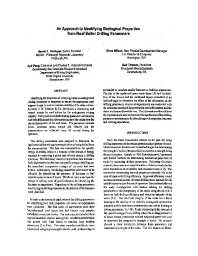Mining Publication: An Approach to Identifying Geological Properties from Roof Bolter Drilling Parameters
Original creation date: August 2000
Identifying the properties of overlying rocks in underground mining operations is important to ensure the appropriate roof support design is used to maintain stability of the mine entries. Recently J. H. Fletcher & Co. developed a monitoring and control system for roof bolters for the underground mining industry. The system records the drilling parameters used during roof bolt drilling and the information can provide insight into the physical properties of the roof strata. The parameters include thrust, rotational speed, torque and velocity and the measurements are collected every 0.1 second during the operation. The drilling parameters were analyzed to determine the application of identifying the strength of rocks being drilled from the measurements. The data was converted into the specific energy of drilling which is a measure of the amount of energy required for removing a given unit of rock during a drilling operation. The laboratory studies completed to date indicate a fairly high correlation between the specific energy of drilling and the unconfined compressive strength of the rocks that were drilled. Additionally, the drilling parameters were shown to be effective for identifying the presence of fractures or bed separations between rock layers. The thrust, torque and specific energy of drilling were all good indicators for identifying the fractures or separations. Regardless of the drilling parameters used during the drilling experiments, the location of the fractures were identified. In order to determine the application of the drilling parameters for identifying roof rock properties, two series of experiments were conducted. The first series of experiments used three "manufactured" roof layers that had various rock samples embedded in concrete blocks. The rock samples included three types of sandstone, marble, and argillite. Another concrete block was poured with foam inserts to simulate large bedding separations (2 to 8-in). Two other manufactured blocks were constructed using high-strength concrete with cardboard layers embedded to simulate smaller fractures or bedding separations. The size of the cardboard layers varied from 1/8- to 1-in thick. One of the blocks had the cardboard layers embedded at an inclined angle to determine the effect of the orientation on the drilling parameters. A series of experiments was conducted with the rotational speed and the penetration rate held constant and the thrust and torque allowed to vary. The information collected from the experiments is used to determine the application of the drilling parameter measurements for identifying rock properties, fractures and bedding separations.
Authors: GL Finfinger, SS Peng, Q Gu, G Wilson, B Thomas
Conference Paper - August 2000
NIOSHTIC2 Number: 20020928
Proceedings of the 19th International Conference on Ground Control in Mining, August 8-10, 2000, Morgantown, West Virginia. Peng SS, Mark C, eds., Morgantown, WV: West Virginia University, 2000 Aug; :1-11
See Also
- Coal Mine Geology in the U.S. Coal Fields: a State-of-the-art
- Detecting and Managing Dynamic Failure of Near-Seam Features in Coal and Nonmetal Mines
- Evaluations of Bit Sleeve and Twisted-Body Bit Designs for Controlling Roof Bolter Dust
- A Gas Pressure-Based Drift Round Blast Design Methodology
- Geologic Characterization
- New Developments with the Coal Mine Roof Rating
- Roof Screening: Best Practices and Roof Bolting Machines
- Roof Support
- Sound Power Level Study of a Roof Bolter
- Technology News 516 - ARMPS-HWM: New Software for Sizing Pillars for Highwall Mining
- Technology News 526 - Proceedings of the International Workshop on Rock Mass Classification in Underground Mining
- Page last reviewed: 9/21/2012
- Page last updated: 9/21/2012
- Content source: National Institute for Occupational Safety and Health, Mining Program


 ShareCompartir
ShareCompartir
